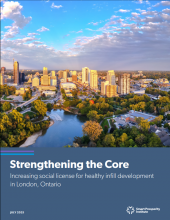How can we build more infill housing while strengthening, rather than degrading, social license for infill housing? That is the question this report explores in the context of London, Ontario.
London's population has boomed over the period analyzed in the report (2010-2025), especially in recent years, when population change has been driven by people moving to London from elsewhere in Ontario (intraprovincial migrants) or directly from other countries (immigrants and net non-permanent residents). Much of this growth has been from people in the Millennial, Generation Z and Generation Alpha cohorts, which concentrates housing demand on the kinds of homes that appeal to couples with kids, singles and roommates.
As in most urban centres in Canada, London has experienced significant increases in housing costs in both the ownership and rental markets, with the CREA Benchmark Single Family more than tripling, hitting a peak of over $831,000 in January 2022 before declining to $669,400 in January 2025. As of the 2021 Census, 42,015 households in London were living in unaffordable housing, defined as spending more than 30% of their income on housing costs. Over the time period, the Canadian Mortgage and Housing Corporation reports 32,734 new housing starts in London, the majority of which, in recent years, are purpose-built rental apartments (~2/3rds of all new homes in 2024 were purpose-built rental units).
The report describes and analyzes 4,059 planning committee decisions in the City of London, over almost 15 years and four distinct municipal council terms, to understand support for (and opposition to) residential infill development. A series of case studies explores examples of both significant opposition (and lack of opposition) to residential infill projects. Over the period in which the comments of speakers were recorded in the minutes or in attached documents, 3,297 speakers were recorded speaking to 910 different items. All together, these comments totalled 772,084 words.
Although residential infill development is often opposed by some residents, and this opposition is covered regularly in local media, planning committee usually decides to support residential infill proposals. Planning committee refused only 4% of applications (Over the time period, 67 refusals passed out of 1,816 zoning bylaw amendment (ZBA), Official Plan amendment (OPA) or site plan application (SPA) motions).
The report proceeds in three parts. First, the socioeconomic context for London, focusing on income, housing and migration. How has the city’s population changed? What kind of housing is available in London and what kinds of households live in those homes? Second, how has the private sector responded to this demand for housing? What kind of housing has been built? Third, what kinds of land use decisions has the city council made over the past 15 years? What is the nature and extent of support or opposition to different kinds of residential infill? To explore these questions, the report presents data, assembled from the minutes of 275 planning committee meetings, covering thousands of committee decisions over the time period, on both the overall sentiment and specific types of emotions expressed during public participation meetings. Next, through a series of case studies, the report explores what we can learn from different kinds of residential infill projects, some of which face opposition and some of which do not. Finally, the report concludes by situating the report’s findings and recommendations in the contemporary context of London’s housing system.
The report makes seven recommendations:
Recommendation #1: A collaborative effort focused on housing
The Whole of Community System Response to Health and Homelessness demonstrates many of the features of a collaborative governance regime: dozens of organizations and hundreds of people attended the summit process and the city has committed to an ongoing whole of community approach (Dickins 2023; Emerson and Nabatchi 2015). Starting and sustaining such a collaborative effort is very challenging. Yet building more homes, especially residential infill, would benefit from a similarly collaborative approach to systems change. Including the people who are most affected by the housing affordability crisis, especially younger generations, as well as the people who are most likely to oppose infill residential housing, may lead to stronger support for residential infill over time. Although establishing such a collaborative effort would take time and resources, given the scale of the housing affordability challenge and the fractious nature of the current approach, it is worth pursuing.
Recommendation #2: More permissive zoning for missing middle and mid-rise residential
Through the combination of place types and street types, the London Plan directs greater residential intensification towards parcels located on major streets. But until the zoning by-law is updated to permit the range of missing middle and mid-rise residential buildings envisioned in the London Plan, site-specific conflict on relatively modest residential infill is likely to continue. Building on its move to permit four residential units as-of-right, the City of London should accelerate the comprehensive update of its zoning bylaw.
Recommendation #3: Focusing infill on underutilized lands
As recommended in Helmer (2023), residential infill on commercial properties such as mall parking lots and underutilized municipal or private surface parking lots may generate less opposition than proposals to build on low-density residential lands do. This kind of infill brings homes closer to major employment centres, which has the potential for additional reductions in congestion and commute times, and has the benefit of substantially limiting the disruption from construction to interior renovations.
Recommendation #4: Infill through conversions
Conversion of vacant or underutilized office buildings to residential, as recommended in Helmer (2023), has the benefit of substantially limiting the disruption from construction to interior renovations. Similar to new buildings on commercial lands or surface parking lots, this kind of infill also reduces the distance between homes and major employment centres.
Recommendation #5: Following up afterwards
At the time a residential infill development is proposed, uncertainty and fear, often about property values decreasing or quality of life decreasing, is at a high point. This time period is also the focal point for the municipality in terms of land use policy. A follow-up by the municipality after developments have been built and occupied, with both the residents of the new homes and the residents of the pre-existing homes, could demonstrate the benefits of residential infill and strengthen support for residential infill overall.
Recommendation #6: Recognizing and celebrating success
Not all residential infill projects are equal. As in any area of business activity, some businesses are better than others in terms of how they plan buildings, engage residents, build the actual building(s), and, in the case of landlords, maintain those buildings. A meaningful award program designed to recognize exemplary residential infill projects may provide a positive feedback effect that improves how residential infill projects are planned and executed over time. The Urban League of London’s Green Umbrella and Green Brick Awards, London Heritage Awards (awarded by ACO London), and the Urban Design Awards (awarded by the City of London) are examples of existing awards that recognize excellent in either environmental contribution or heritage conservation. A new award program focused specifically on residential infill could be a way to recognize and celebrate success in this area.
Recommendation #7: A focused, proactive strategy for built heritage
Proponents of conserving built heritage often support residential infill proposals on underutilized land or involving adaptive re-use of heritage buildings. However, they are often opposed to residential infill development that is perceived to threaten built heritage resources. A focused, proactive strategy to acquire and conserve built heritage resources, and to encourage their redevelopment as new residential homes, will help to build social licence for residential infill. This strategy could include a dedicated fund for acquiring built heritage resources and/or a program to incentivize the adaptive re-use of built heritage resources for residential purposes, building on the existing city-wide Heritage Community Improvement Plan.



